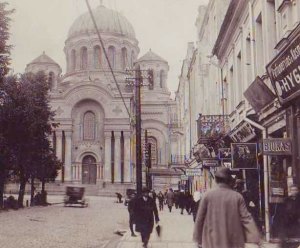As a consequence of the late 19th Century czarist ban on the Lithuanian language and the attack on Catholic village schools, most of the immigrants who arrived in Springfield, Ill. during the early 1900s were illiterate or barely literate. Having communities and churches abroad, like Springfield’s St. Vincent de Paul Lithuanian Catholic Church, where the immigrants could speak Lithuanian and express their religious and ethnic aspirations, was very important.

The oldest surviving manuscript in Lithuanian (around 1503), rewritten from 15th century original text.
It’s ironic that immigrants found more freedom to be Lithuanian and Catholic in the United States than in their oppressed homeland. However, in a further irony, the very language and identity Lithuanians could finally express in freedom on U.S. soil was also constantly under pressure to assimilate into the American mainstream.
These forces of assimilation proved irresistible across the generations, as they did for other European ethnic groups in Springfield. However, through most of the 20th Century, oppression of Lithuanians in their homeland continued to provide a strong moral imperative for preserving Lithuanian identity abroad.

